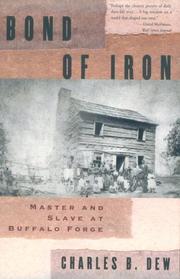Check nearby libraries
Buy this book

The records dealing with the Buffalo Forge slaves are unique in their completeness; never before have details of this life in the American South been so rich, so exacting, and so accessible to historian and general reader alike.
Historian Charles Dew's exhaustive study of the Buffalo Forge asks - to use Charles Joyner's wonderful phrase - "large questions in small places"; he describes what working and living conditions were like for the slave artisans and their families, traces patterns of accommodation and resistance, and elucidates the complex interaction between white and black that constituted the inner core of the master-slave relationship.
Buffalo Forge was an extensive ironmaking and farming enterprise located approximately nine miles southeast of Lexington in the Valley of Virginia. This property was developed in the antebellum period by two men: William Weaver, a Pennsylvania entrepreneur who made his initial investment at Buffalo Forge during the War of 1812, and Daniel C. E.
Brady, another Pennsylvanian and a relative of Weaver's whom Weaver brought down to the valley during the 1850s to assist him in managing the Buffalo Forge operations. By the time of the Civil War, Weaver had amassed an extraordinary estate which included a force of seventy owned slaves plus an additional force of as many as one hundred slaves hired annually, whom he employed in both iron-manufacturing and agricultural tasks.
During the antebellum years, he operated two charcoal-fired blast furnaces and two well-equipped forges for the production of bar iron, and held over 20,000 acres of land scattered across three counties in the Valley.
Almost every job on the Buffalo Forge property, from the most highly skilled to the most ordinary, was performed by slave labor. The story of William Weaver's slaves is told through slave birth, illness, and death records kept assiduously by Weaver and later by Brady. The fortuitous survival of these documents is an invaluable addition to the history of slavery, allowing us a fully integrated, day-to-day look at the slave community's function and development.
Weaver-Brady records describe the deadly progress of epidemics and crippling industrial accidents among their slave force; in noting all slave births, they permit the construction of detailed slave genealogies and reveal slave-naming practices. The Freedman's Bureau Marriage Register for the county in which Buffalo Forge was located also survives. This exceedingly valuable document reflects the effort by the bureau to encourage the freedmen to come in and record (and thereby legalize) marriages entered into while the husband and wife were still enslaved.
Almost all of the Buffalo Forge black families are in this register, and many of the dates given by the former slaves can be confirmed by reference to records in the Weaver-Brady papers.
Another key item in the Weaver-Brady papers is the "Home Journal" kept by Daniel Brady from 1858 through 1865.
This three-volume diary recounts what each industrial and agricultural slave laborer was doing at Buffalo Forge on every working day; Brady evaluates their performance, describes the movements of the slave patrols and whom they punished, and tells the story of the Civil War - how the slaves reacted when Federal troops entered the valley, and how the black men and women made the transition to freedom in the months following emancipation.
The documentary evidence dealing with the slaves of Buffalo Forge provides an extraordinary opportunity to reconstruct, from manuscript and oral history sources, the story of slave life as it was lived during the antebellum and Civil War years; these materials also offer a chance to trace the history of these men and their families into the Reconstruction and post-Reconstruction eras. There is no other book quite like this in its massive and ambitious historiography of American slavery.
Bond of Iron has a significance that far transcends the geographic confines of Buffalo Forge; it makes a distinct and genuine contribution toward understanding slavery, and slave life, in the American South.
Check nearby libraries
Buy this book

Previews available in: English
Showing 3 featured editions. View all 3 editions?
| Edition | Availability |
|---|---|
|
1
Bond of Iron: Master and Slave at Buffalo Forge
November 1995, W. W. Norton & Company
in English
039331359X 9780393313598
|
zzzz
Libraries near you:
WorldCat
|
|
2
Bond of Iron: Master and Slave at Buffalo Forge
November 1995, W. W. Norton & Company
in English
039331359X 9780393313598
|
aaaa
Libraries near you:
WorldCat
|
|
3
Bond of iron: master and slave at Buffalo Forge
1994, W.W. Norton
in English
- 1st ed.
0393036162 9780393036169
|
cccc
Libraries near you:
WorldCat
|
Book Details
ID Numbers
Links outside Open Library
Community Reviews (0)
Feedback?History
- Created April 29, 2008
- 8 revisions
Wikipedia citation
×CloseCopy and paste this code into your Wikipedia page. Need help?
| August 18, 2020 | Edited by ImportBot | import existing book |
| April 28, 2011 | Edited by OCLC Bot | Added OCLC numbers. |
| August 5, 2010 | Edited by IdentifierBot | added LibraryThing ID |
| April 24, 2010 | Edited by Open Library Bot | Fixed duplicate goodreads IDs. |
| April 29, 2008 | Created by an anonymous user | Imported from amazon.com record |














